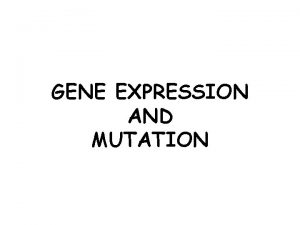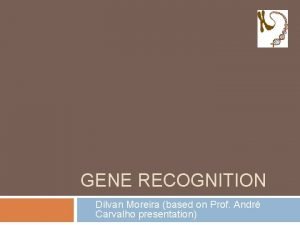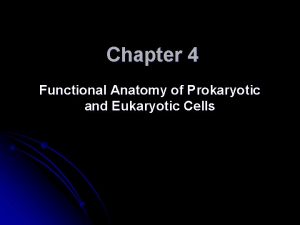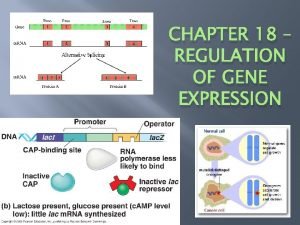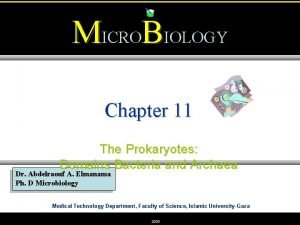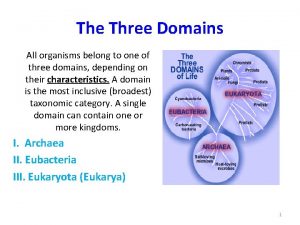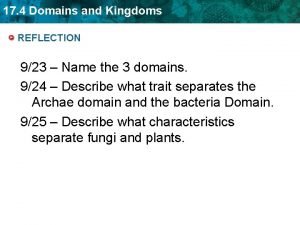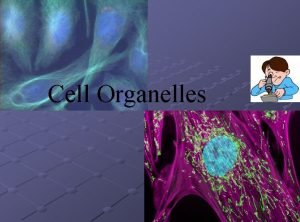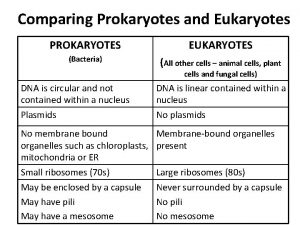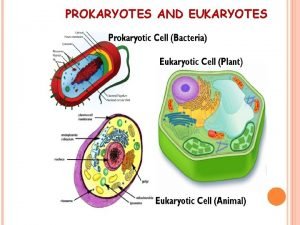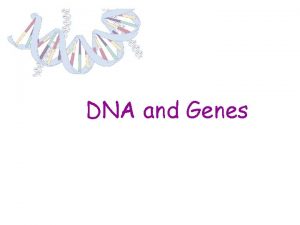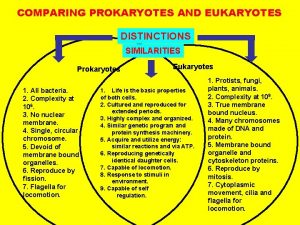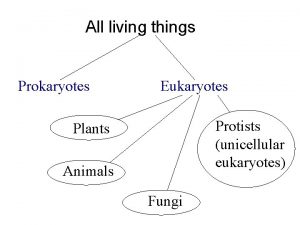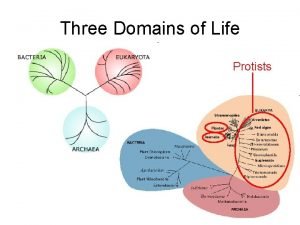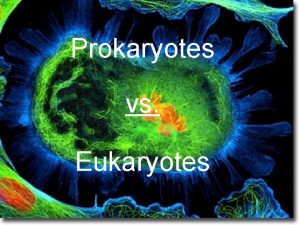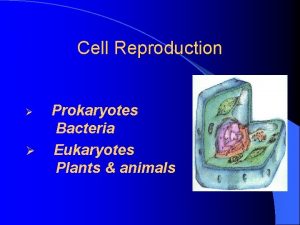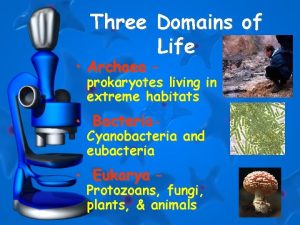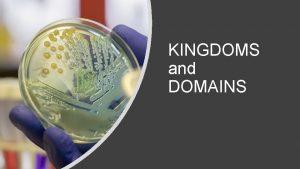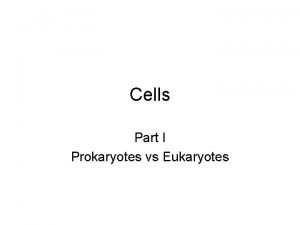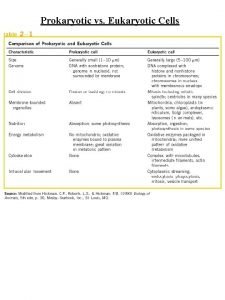CELLS Prokaryotes and Eukaryotes THREE DOMAINS OF LIFE






































- Slides: 38

CELLS Prokaryotes and Eukaryotes

THREE DOMAINS OF LIFE

THREE DOMAINS OF LIFE

THREE DOMAINS OF LIFE Bacteria & Archaea- Eukaryotes Prokaryotes (this domain includes organisms you are familiar with such as protists, plants, animals, fungi, and you!)

SIMILARITIES AMONG THE DOMAINS have cell membranes cytoplasm & cytosol (materials inside the cell) ribosomes (RNA+protein complex involved in protein synthesis) have a common set of metabolic pathways (including glycolysis) replicate DNA semiconservatively use DNA as genetic material and a similar genetic code to make proteins This serves as evidence that all living things are related

DIFFERENCES AMONG THE DOMAINS Prokaryotes Eukaryotes all organisms are unicellular some eukaryotes are multicellular Cell Division Binary fission Mitosis Organization of Genetic Material no nucleus! Nucleoid (region where DNA is located), circular DNA, most have 1 chromosome Membrane-bound nucleus, multiple chromosomes Compartmentalization lack most organelles! Membrane-bound may have infoldings of cell organelles membrane

DIFFERENCES Prokaryotes all organisms are unicellular Eukaryotes some eukaryotes are multicellular

EUKARYOTES SHARE A MORE RECENT COMMON ANCESTOR WITH ARCHAEA THEN THEY DO WITH BACTERIA. Genetic Evidence: Sequencing of ribosomal RNA (r. RNA) genes has been useful in studying these relationships because § r. RNA was present in the common ancestor of all life. § All free-living organisms have r. RNA. § Lateral transfer of r. RNA genes among distantly related species is unlikely. § r. RNA has evolved slowly.

PROKARYOTE STRUCTURE Cell membrane- encloses the cell, separates internal environment from external environment, regulates traffic of materials into and out of the cell Nucleoid- region where DNA is located Cytoplasm- inside the cell, constantly in motion § cytosol- water containing ions, small molecules and soluble macromolecules § Variety of filaments and particles, including ribosomes Ribosomes- tiny complex of RNA and proteins, sites of protein synthesis § Found floating freely in the cytoplasm

SPECIALIZED STRUCTURES OF (SOME) PROKARYOTES Cell walls (most prokaryotes have)- supports cell and determines shape § Some bacterial cell walls made of peptidoglycan § Some bacterial cells have capsules than protect from white blood cells and help keep cells from drying out

SPECIALIZED STRUCTURES OF (SOME) PROKARYOTES Flagella- for motion! little appendage anchored in the cell membrane made of motor proteins

SPECIALIZED STRUCTURES OF PROKARYOTES ( I N S O M E P R O K A R Y O T E S ) Cytoskeleton- filaments that play a role in cell division § What kind of experiment could we design to know that flagella are for movement? § Why would this be an evolutionary advantage?

PROKARYOTES ARE VERY DIVERSE. SUPER AWESOME EXAMPLES: Hypertehrmophiles- could have lived in ancestral Earth

PROKARYOTES ARE VERY DIVERSE. SUPER AWESOME EXAMPLES: Hadobacteria- live in extreme environments § Thermus aquaticus- lives in hot springs § HUGE for PCR (and science in general) § Deinococcus- resistant to radiation and can consume nuclear waste and other toxic materials.

PROKARYOTES ARE VERY DIVERSE. SUPER AWESOME EXAMPLES: Cyanobacteria (aka. bluegreen bacteria)- photosynthetic bacteria, have chlorophyll and release for photosynthesis and release O 2 § some can also fix nitrogen § responsible for transforming the earth's atmosphere

PROKARYOTES ARE VERY DIVERSE. SUPER AWESOME EXAMPLES: Proteobacteria : largest group of bacteria Mitochondria of eukaryotes were derived from a proteobacterium by endosymbiosis. Examples: § § Some are photoautotrophs that use light energy to metabolize sulfur Rhizobium- nitrogen fixers Escherichia coli- one of the most studied organisms on Earth. Salmonella typhimurium- causes GI disease

Don’t get mixed up… COMMON MISCONCEPTIONS Not all bacteria are harmful. Most bacteria are harmless. Some are really important! Many play critical roles in decay, matter cycling and organismal health.

Before we move on to eukaryotes, let’s backtrack a second The Cell Theory Cells are the fundamental units of life All living things are composed of cells All cells come from preexisting cells Conceptual implications: § Studying cell biology is in some sense the same as studying life § Life is continuous

EUKARYOTES Monophyletic (one common ancestor) More closely related to Archaea than to Bacteria Includes plants, animals, fungi, and protists § Protist- all the eukaryotes that are not plants, animals or fungi (nonmonophyletic, many groups)

EUKARYOTIC CELLS HAVE A CELL MEMBRANE, CYTOPLASM, AND RIBOSOMES (SOUND FAMILIAR? ) § Cytoplasm § Ribosomes- free in cytoplasm (just like prokaryotes), attached to endoplasmic reticulum, inside mitochondria and chloroplasts

EUKARYOTIC CELLS HAVE A CELL MEMBRANE, CYTOPLASM, AND RIBOSOMES Cell membrane- selectively permeable barrier that allows cells to maintain homeostasis (stable internal environment) § phospholipid bilayer § decorated in proteins § vital for cell communication

THE KEY IS COMPARTMENTALIZATION. Eukaryote s have organelles. § Each organelle plays a specific role in the cell.

MAD SKILLS: SURFACE AREA-TO-VOLUME RATIO

the volume of a cell determines the amount of metabolic activity The surface area of a cell determines how much material can pass through SURFACE AREA-TOVOLUME RATIO as an object increases in volume, its surface area also increases, but not as quickly It limits cell size.

the volume of a cell determines the amount of metabolic activity The surface area of a cell determines how much material can pass through SURFACE AREA-TOVOLUME RATIO as an object increases in volume, its surface area also increases, but not as quickly It limits cell size.

Important because as cells grow larger, metabolic activity increases and the cell needs more resources and to get rid of more waste SURFACE AREA-TOVOLUME RATIO as an object increases in volume, its surface area also increases, but not as quickly It limits cell size.

Surface Area Adaptations § Cells have adapted to maximize surface area when material exchange needs to be maximized. § Ex. Lung alveoli, and plant root hairs SURFACE AREA-TOVOLUME RATIO as an object increases in volume, its surface area also increases, but not as quickly It limits cell size.

What you need to be able to do: Be able to calculate the surface area and volume of a 3 D cell and determine the relative efficiency of material exchange. The formula sheet has formulas for surface area and volume for a variety of 3 D shapes. Ex. Determine the relative efficiency of material exchange for a spherical cell with a radius of 10 μm, and a cubic cell with a side length of 10 μm. SURFACE AREA-TOVOLUME RATIO as an object increases in volume, its surface area also increases, but not as quickly It limits cell size.

MEET THE ORGANELLES- NUCLEUS Nucleus § § Usually the largest organelle Where DNA is located Where DNA is transcribed to RNA Has nucleolus were ribosomes are made

MEET THE ORGANELLESENDOMEMBRANE SYSTEM Endoplasmic Reticulum (ER) § Network of interconnected membranes § Extensive folding awesome surface area-to-volume ratio § Inside called lumen Rough Endoplasmic Reticulum (RER) § Ribosomes attached (not permanently, just when they are synthesizing proteins to be modified by the RER) 1. Protein enters RER (if it has the right AA sequence) 2. Proteins are folded into their tertiary strucure 3. Proteins are chemically “tagged” (often with CHO groups) for delivery 4. Proteins are pinched off from ER and transported in vesicles § All secreted proteins and most membrane-bound proteins are made in RER

BELL RINGER 1. Which of these statements accurately reflects the relationship between cell size and surface area? a. Larger cells are most efficient at transporting materials across the membrane since their surface area is increased. b. Smaller cells must have more phospholipids per area in order to adequately transport materials into the cell. c. Cells must maximize their surface area to volume ratio in order to maintain homeostasis. d. Cells must minimize their surface area exposure to the extracellular matrix in order to retain cytosol. 2. Calculate the surface area and volume of a cubic epithelial cell with sides of 8 micrometers. Then, illustrate the relationship between cell size (x axis) and surface area/volume ratio (y axis) on a graph.

MEMBRANES AND TRANSPORT Membranes- separate the inside of the cell from the surrounding environment § structure and function determined by its composition § it controls transport

MEMBRANE- FLUID MOSAIC MODEL

MEMBRANE- FLUID MOSAIC MODEL Phospholipid bilayer § amphipathic. Hydrophilic outside, hydrophobic inside § Spontaneously form a bi -layer Fluidity- molecules can move around within the membrane § dependent on lipid composition and temperature § cholesterol (steroid lipid) helps to maintain membrane fluidity

PLASMA MEMBRANE Selective Permeability only small, nonpolar molecules can move through the bilayer Other materials must move through pores (made of proteins)

PLASMA MEMBRANE- PROTEINS Structure Integral- penetrate one or both layers of bi-layer Peripheral- don’t penetrate the bilayer

PLASMA MEMBRANE- PROTEINS Structure Int eg ral- pene trate one or bot h layers of bi-lay er Pe riph eral- don’t pe ne trat e the bila ye r Function include: move materials through the membrane- pores cell-cell recognition receive chemical signals from environment

PLASMA MEMBRANE- PROTEINS
 Diff between prokaryotes and eukaryotes
Diff between prokaryotes and eukaryotes Prokaryotes and eukaryotes
Prokaryotes and eukaryotes Prokaryotes and eukaryotes
Prokaryotes and eukaryotes Multiple choice questions on prokaryotes and eukaryotes
Multiple choice questions on prokaryotes and eukaryotes Gene prediction in prokaryotes and eukaryotes
Gene prediction in prokaryotes and eukaryotes Repressible operon
Repressible operon Prokaryotes and eukaryotes
Prokaryotes and eukaryotes Are red blood cells prokaryotic
Are red blood cells prokaryotic Anatomy of prokaryotes and eukaryotes
Anatomy of prokaryotes and eukaryotes Prokaryotic vs eukaryotic transcription
Prokaryotic vs eukaryotic transcription Prokaryotes vs eukaryotes gene regulation
Prokaryotes vs eukaryotes gene regulation Prokaryotic and eukaryotic venn diagram
Prokaryotic and eukaryotic venn diagram Eukaryotic cells vs prokaryotic
Eukaryotic cells vs prokaryotic Prokaryotes vs eukaryotes
Prokaryotes vs eukaryotes Prokaryotic and eukaryotic cells chart
Prokaryotic and eukaryotic cells chart Prokaryotic vs eukaryotic cells venn diagram
Prokaryotic vs eukaryotic cells venn diagram Staphylococcus
Staphylococcus Three domains
Three domains 4 domains of life
4 domains of life Domain of prokaryotic cells
Domain of prokaryotic cells Onodi cells and haller cells
Onodi cells and haller cells Red blood cells and white blood cells difference
Red blood cells and white blood cells difference Plant cell and animal cell venn diagram
Plant cell and animal cell venn diagram Masses of cells form and steal nutrients from healthy cells
Masses of cells form and steal nutrients from healthy cells What are the three domains and six kingdoms?
What are the three domains and six kingdoms? Chapter 17 section 1 the history of classification
Chapter 17 section 1 the history of classification Transport maximum
Transport maximum Thyroid gland
Thyroid gland How are somatic cells different from gametes
How are somatic cells different from gametes Somatic cells vs germ cells
Somatic cells vs germ cells The organelle trail
The organelle trail Pseudostratified vs simple columnar
Pseudostratified vs simple columnar 4 types of eukaryotic cells
4 types of eukaryotic cells Nondisjunction in meiosis
Nondisjunction in meiosis Cell substance
Cell substance Is animal cell prokaryotic or eukaryotic
Is animal cell prokaryotic or eukaryotic Genetic linkage and mapping in eukaryotes
Genetic linkage and mapping in eukaryotes Levels of critical reading
Levels of critical reading The three domains are _____.
The three domains are _____.
